Install diagonal supports to rear assemblies
Posted: 2005-April-12 Filed under: Frame, Projects, The Bike With 2 Brains Leave a comment »I got the diagonal supports that tie the steering tube to the midpoint on the seat back. My calculations were off somewhere and the support is higher on the seat back than I had expected so I'll need to make some adjustments: I had originally designed the line of the support to pass through the seat back and cross the bottom of the seat but now it won't.
Order the LED's
Posted: 2005-April-11 Filed under: Lighting, Projects, The Bike With 2 Brains Leave a comment »I got on the LSDiodes.com website and found the full-spectrum LED's were out of stock; it turns out they won't be available for around a month. I decided to get 3mm red/blue LED's and 3mm green LED's instead — the voltages are a little different, but overall they are much brighter (almost 3x) than the full-spectrum LED's.
Begin building rear frame; great dumpster find
Posted: 2005-April-11 Filed under: Frame, Projects, The Bike With 2 Brains Leave a comment »I found a fence gate in the trash the other day and the tubing has the same inside diameter as a bicycle steering tube. I cut a couple pieces and tack-welded the top rear tube to the steering tube at a right angle. I'm using a grinder to create the rounded seams — sometimes I do a really good job and others will need some fill material. For the right angles, I've got magnetic holders to square them up. On the other end of the top tube, I welded a short length of 3/4" schedule-style threaded pipe. This way I can thread together the frame as needed.
The The University of Rochester Medical Center (601 Elmwood Ave.) is just down the street from my house, and they just recently closed their surplus sale site to demolish the building sometime in the future. During cleanup, they had thrown out the bed frames that rotate — I don't know what they're called, but they've got big steel hoops on each side. They had cut them up, but I snagged two pieces that I hope to use for the top of the vehicle frame. They were 72 inches across and 25 inches high &mdash approximately half of one of the hoops. I put representations in the CAD drawing and they're arcs from an 80-inch diameter circle. I'll need to bend them tighter than they are currently, but at least it's a start and will save me the trouble of starting from scratch with straight tubing.
Chop up bike frames
Posted: 2005-April-10 Filed under: Frame, Projects, The Bike With 2 Brains Leave a comment »I chopped up 4 bike frames and now have enough pieces of adequate length to make both sides of the rear end.
Find out about professional paint services
Posted: 2005-April-7 Filed under: Frame, Projects, The Bike With 2 Brains Leave a comment »Short update: I stopped by Mac's II Collision (3301 Brighton-Henrietta Townline Rd.) to ask about getting a bike frame painted but they said they wouldn't do it. However, I can get automotive quality paints next door and special primers for zinc coatings (like some of the pipe.)
More rear-end redesigning; first welds
Posted: 2005-April-5 Filed under: Frame, Projects, The Bike With 2 Brains Leave a comment »I found that I had some problems in the back end. First, the tubing I expected to use was longer than any bike tubes I had, so I made them all shorter. However, I had drawn the wheels castering backwards: if the wheel were to spin 180 degrees from where I had drawn it, it would strike the frame.
The forks I have vary but the axle was typically 2"-2.5" from center — I had estimated 3 inches in my original drawing. I also measured the distance from the bottom of the steering bracket to the top of the wheel, and that's about 4 inches, but I had only given 1 inch in the original drawing so I increased it and adjusted the other parts. In the process, I added some more support.
I worked on the bike frames and cut enough pieces to make one side of the rear of the frame. I wasn't going to have enough time before sunset to finish the frame, but I did get out and weld the eyes together. There were a few strokes of the welder that went really well, and as I went, I improved. I had to grind a lot of material away to get it to a reasonably attractive shape, but it otherwise looks pretty good.
Generators #4: A New Hope — AC generators
Posted: 2005-April-2 Filed under: Power Source, Projects, The Bike With 2 Brains Leave a comment »I figure I can easily convert a DC motor to an AC motor by tying one side of the rotor windings to both sides of the brush assembly rotor thing, and the other side to the shaft. That way I can step up the output voltage to a useable level.
I went to the basement and grabbed all the motors. I decided to try converting the drill motor since it generated the highest current (next to the original) and it's the largest. I decided against the air pump motor because, although it can source a lot of current, the output voltage is so low it's almost not worth it … then again, that's based on running it up to 3,100 RPM on the drill press, not the huge speeds from spinning on the rubber wheel.
Anyway, I took apart the gold-colored motor and rewired it. I started by cutting a groove around the commutator and soldering the original poles together so I ended up with a 2-pole slip-ring instead of a 3-pole commutator. I ground down the brushes so each would contact one pole of the slip-ring. I disconnected the three poles, undid the connection that tied the windings in a loop and connected each end to the slip-ring contacts.
When I reassembled it and tested it, I roughly zero volts out. I had successfully demonstrated that the motor was wired efficiently and Kirchoff's laws still apply: of course there was no current flowing at that point — otherwise, when run as a motor, it would short-out. Dummy.
I took it apart again and wired it for 3-phase. Two phases were wired to the brush output, and the third was soldered to the shaft bushing so I could use the case as the third phase. It sort-of worked, but then the wire I was using to tie the third leg to the shaft came loose and wedged between the rotor and the magnets.
I reassembled the motor with a stiffer wire. I found that the brushes would bounce on the imperfect rings I had so they wouldn't transfer the power. I could get up to about 1 amp of output on any one coil and up to 1.5 volts or so. I cleaned up the rings and such but couldn't get them round enough with the tools I had so I gave up on it.
However, I also had an AC brush motor from a Dirt Devil hand-held vacuum and figured I could make a rotor with permanent magnets to induce current in the outer coil. Finally a break in all this: the rotor shaft was 5/8" which is the same size (well, 8mm) as the the bearings I bought for the Savonius rotor. Even better, the magnets in the gold-colored permanent magnet motor are very close to the right size.
Generators #3: Experimentation
Posted: 2005-April-1 Filed under: Power Source, Projects, The Bike With 2 Brains Leave a comment »I tested some of the motors at high-speed to see how much they'd generate and to see if any would be suitable. Note that the motor speed was dictated by the shaft diameter; the drill motor, 6V motor, and original motor had larger shafts and ran slower.
Motor
open
voltage
voltage
@ 3 ohms
power
@ 3 ohms
drill
> 4.7
4.6
7.0 watts
gold
> 4.5
4.6
7.0 watts
silver
> 3.0
3.7
4.6 watts
6V motor
> 6.5
4.6
7.0 watts
original
> 14.0
7.5
18.8 watts
For the stepper motor, at 1,100 rpm, using both phases through a bridge rectifier, it would source 0.63V into 3 ohms or 0.13 watts. One phase through a 5:1 step-up transformer frustratingly yielded the same results: 0.6V. Both phases in series yielded 0.67 volts, and at 1,720 RPM, 0.8 volts. The open voltage on the transformer secondary was 11.75 volts.
I also took apart one of the pumps that I used to use for the air horns in the car and got its motor separated. It could source 3 volts into 3 ohms and had a short-circuit current of 5 amps at 3,100 RPM.
Generators #2: Stepper motors suck as generators
Posted: 2005-March-31 Filed under: Power Source, Projects, The Bike With 2 Brains Leave a comment »I decided to go buy a motor so I went to Glenwood Sales (549 Hague St.) and browsed for a while before eventually settled on a 30 V stepper motor with a 48 ohm coil. It apparently has 4 phases, and each phase would ordinarily consume 0.625 A or 18.75 watts.
The stepper motor could generate as much as 50 volts open-circuit (it's wired with two coils center-tapped.) Through a 51-ohm load I found it could get as high as 5 volts, and through a 280-ohm load, 20 volts. The good news is it's pretty linear from about 1,000 RPM through 3,000. The bad news is those two ratings yield only 0.5 watts and 1.4 watts respectively.
Using a full-wave bridge on each side and tying the outputs together and running at 3,100 RPM, I could get 9 volts into 51 ohms and 34 volts into 280 ohms: 1.6 watts and 4.1 watts respectively. Open, it would generate 90 volts. Indeed, none of the motors would source more than a half a volt at 3,100 RPM; one that I hadn't tested would generate 0.5 V and 1.5 amps, so at least that's promising.
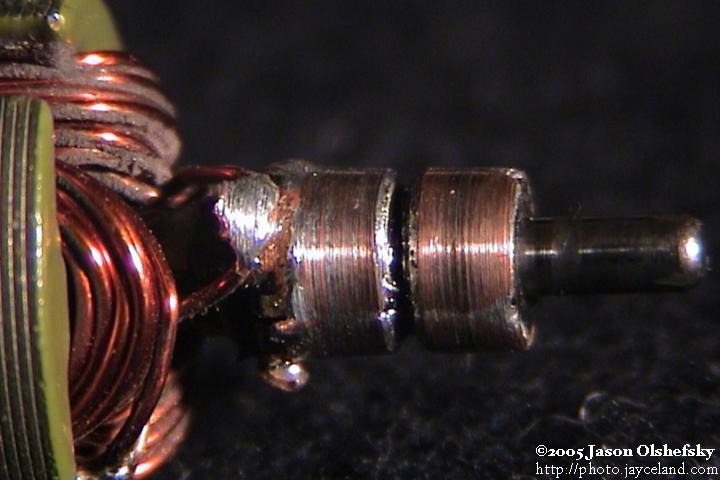
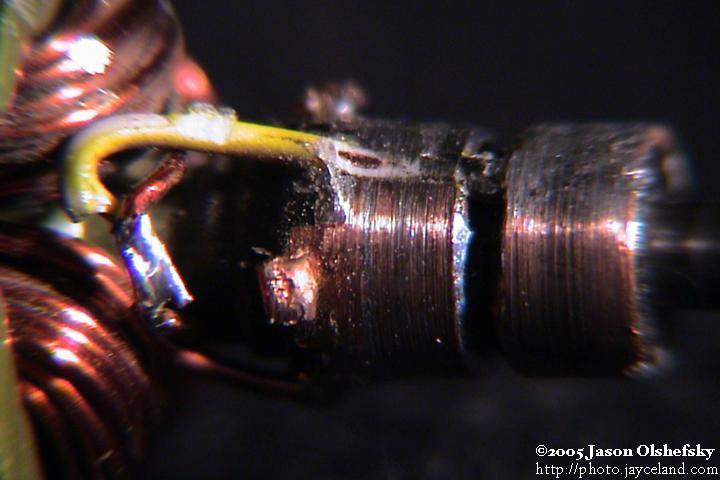
Method of mounting the rotor bearings; Generators #1: These generators suck
Posted: 2005-March-28 Filed under: Power Source, Projects, The Bike With 2 Brains Leave a comment »I found that I have some 1" thin-walled tubing from an exercise machine that has a nearly 22mm diameter — the outside diameter of the bearings I bought. I figure I can weld a piece of tubing to the ends of the windmill frame then cut a slot and use a seat-post clamp to grip the bearing.
I also tested the motors I had selected as candidates for a 10-watt generator. None of them performed better than the motor I had originally selected.
Based on my former calculations, the rotors would only run at 300 RPM in a 10 MPH wind, so a 7x gear-up would only yield 2,100 RPM which wasn't enough to generate any appreciable power. To get any power out, I had to run the baby carriage wheel in the drill press at 620 RPM with a 0.33" gear, so the ratio to the 7 3/4" wheel (23.5x) means I ran the motor at 14,500 RPM. If this were 20 mile-per-hour wind, then a 70 mile-per-hour wind would overcrank the motor to over 50,000 RPM and probably blow it up. I'll have to see how slow I can get the motor to run and still get decent power. Well, I know that 3,100 RPM is not enough: the motor, when hitched directly to the drill press, would only generate about 3.4 volts open and 1.9 volts into 3 ohms (only about 1 watt.)
Ok, so let's say I limit the motor to 15,000 RPM at maximum wind speed of 70 MPH, or 2,100 RPM. The ratio, therefore, is 7:1 … bummer. I think I'm going to need to get a different motor. If I use 21,000 RPM as the cap, I can get to a ratio of 10:1, so in a 10 MPH wind, the rotors would only run at 300 RPM driving the motor at 3,000 RPM which isn't enough.


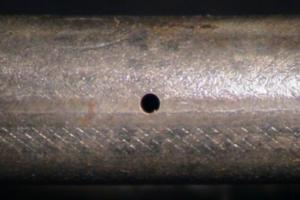
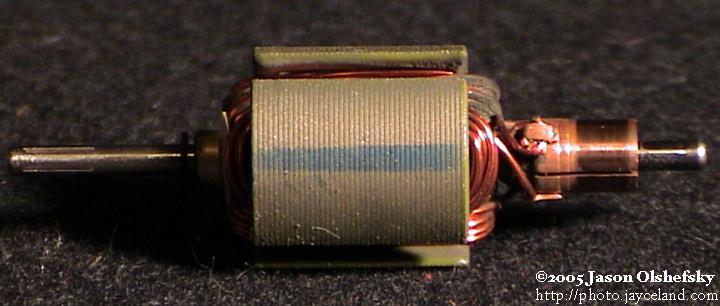
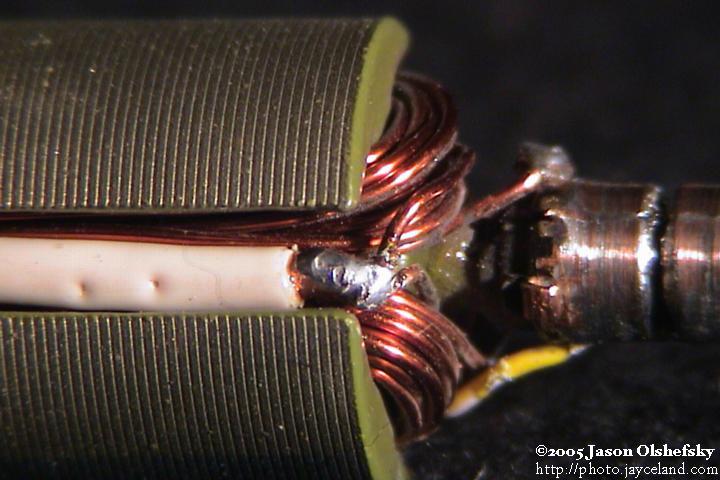

Recent Comments